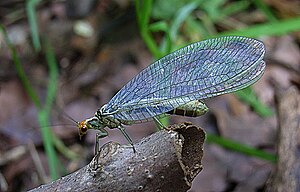Red-headed lacewing
| Red-headed lacewing | ||||||||||||
|---|---|---|---|---|---|---|---|---|---|---|---|---|

Red-headed lacewing ( Nothochrysa fulviceps ) |
||||||||||||
| Systematics | ||||||||||||
|
||||||||||||
| Scientific name | ||||||||||||
| Nothochrysa fulviceps | ||||||||||||
| ( Stephens , 1836) |
The red-headed lacewing ( Nothochrysa fulviceps ) is a reticulated wing fly from the family of lacewing (Chrysopidae). The unusually large animal is seldom seen, as it prefers to be in the forest and at the edges of the forest at a height of several meters above the ground.
features
The red-headed lacewing belongs to the subfamily Nothochrysinae . This is considered to be the most original of the three subfamilies of lacewings. In contrast to the other two subfamilies, the Nothochrysinae have no hearing organ at the base of the forewings. The fore wing at the base is also slightly bulged towards the rear (jugal field, yellow in Fig. 2). The front and rear wings are hooked together via a small bristle on the hind wing (frenulum). Fore and hind wings are similarly built and richly veined. The leading edge of the wings is formed by the Costa longitudinal artery. The two following longitudinal arteries, Subcosta and Radius, run parallel to each other with a small distance. (Fig. 2, ocher and brown). The area between the Costa and Subcosta, the Kostal field (in Fig. 2 at the lower edge of the wing), is divided by many transverse veins that are unbifurcated. A longitudinal artery, the posterior median (MP, dark blue in Fig. 2) splits into two arteries (MP1 and MP2, light blue in Fig. 2) and then reunites as pseudomedians (Psm, turquoise in Fig. 2). This pseudomediane does not run in a straight line, but in a flat zigzag line up to the inner zigzag line (gradate row, green in Fig. 2) and does not, as in the subfamily Chrysopinae, reach the outer gradate row (pink in Fig. 2).
The reddish head has two protruding complex eyes that shine metallic gold. Point eyes ( Ocelli ) are missing. The multi-part antennae reach approximately the end of the abdomen. The mouthparts point vertically downwards (orthognath) and are of the biting type. The mandibles are strong. The jaw buttons are tripartite, the lip buttons are tripartite .
The side of the breast section has dark brown markings and is not a single red-brown color. The legs have five-limbed tarsi that are built identically (homonomous). The claws are widened at the base. With a length of 19 to 25 millimeters, the wings protrude far beyond the abdomen. They are transparent and colorless.
The abdomen consists of nine visible limbs, the first eight carry a pair of spirals .
Larvae
The larvae have three trained pairs of legs and are predatory. The head is stretched forward and has long, pointed jaws. The antennae are thread-shaped and longer than the jaws. There are six point eyes on each side of the head.
distribution
The species is only found scattered in Europe, while both Northern Europe and the Mediterranean area do not fall within the range. Only sites are known that are less than 500 m above sea level.
Way of life
The adults cannot fly particularly well (flutter flight). They are crepuscular and feed on honeydew and pollen . As with almost all lacewings, the larvae are predatory. The chitinized parts of the prey animals sucked out by them are attached to the back by long hooked bristles (debris-carrier). Pupation takes place in a cocoon .
The species probably develops exclusively in hardwoods. There are probably three larval stages. Adult animals were only caught sporadically and on deciduous trees ( oak , field maple , hornbeam ); warm mixed deciduous forests without conifers are preferred. The adults are found from May to September, it is unclear whether they are one or two generations. The wintering takes place in the prepuppa stage .
swell
- Michael Chinery: Parey's Book of Insects . Paul Parey Publishing House, Hamburg and Berlin, ISBN 3-490-23118-X
- H. Aspöck et al .: The Neuroptera of Europe . Goecke and Evers, Krefeld 1980
Web links
- Nothochrysa fulviceps in Fauna Europaea

